Obverse Busts of the Revolutionary Coinage of Oaxaca (1915-1916)
by Scott Doll
The coins from the State of Oaxaca during the Mexican Revolution include some of the highest quality pieces struck during those tumultuous times. They also have the distinction of having some of the most diverse and distinct coins from a variety perspective, having a wide array of obverse and reverse die varieties as well as numerous edge types. Oaxaca also used an assortment of metals on the planchets to include gold, silver, copper, brass, lead, as well as other multi-metal or bi-metal mixtures have been documented. All of this makes for a remarkably interesting and fun series to collect.
All Oaxaca coins from the revolution carry a date of 1915, except for the 1 centavo (rectangle) which has no date and the 60 pesos which has a date of 1916. One of the many aspects of these coins is the large quantity of busts that can be seen on the coins. In fact, there are ten known busts which were used on the coins from Oaxaca and can be seen on the 1 centavo all the way up to the 60 pesos. This is utterly amazing to think that the mint engravers went to all that time and trouble to create so many different bust designs of a single individual.
When I was first introduced to the coins of Oaxaca back in the mid-1990s, I must admit that I was quite unimpressed. Looking back, that was such an uninformed and narrowminded view of this series. I now see them for not only their attractiveness and high quality, but also for the sheer number of varieties which can be a very daunting endeavor for the collector who wants to collect one of every variety available from this series. Since many of the issues in copper are readily available, that should be the starting point for most collectors. However, some of the scarce copper varieties, as well as majority of the silver and gold issues, are a different story and will take time, patience and a little more money to collect, especially by variety. Looking at things more simply, this article is going to focus on the ten known busts and not any of the different obverse varieties containing those busts. It is also not going to go into any detail regarding the different reverse varieties since that would entail a much larger and detailed discussion.
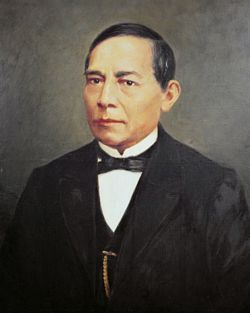 Before I delve deeper into each of the different busts, let us first start by talking about the individual who is on that coinage. That person is Benito Juárez who lived from 1806 to1872. He was born in Oaxaca to poor, indigenous farmers and was orphaned at a young age. He eventually moved to Oaxaca City where he was aided by a Franciscan who helped him continue with his education, whereupon he later enrolled in the seminary. Growing up he had an interest and passion in liberal politics and eventually enrolled in the Institute of Sciences and Arts where he studied law. Upon graduation, he served in multiple capacities as a lawyer, prosecutor, civil judge, state legislator, governor and later as the President of the Mexico Supreme Court of Justice. It was this last position that helped elevate him to assume the presidency upon the resignation of President Ignacio Comonfort. Upon this resignation, Juárez became the 26th President of Mexico and held that position from 1858 to1872. He also has the distinction of being the first president of Mexico of indigenous origin, of Zapotec ethnicity. He was generally held in high regard and was seen as a man of the people and worked throughout his presidency trying to improve the lives of indigenous Mexicans. On a historical side note, Juárez was also the individual who authorized the execution by firing squad of Emperor Maximilian who occupied part of the country during the French Intervention (1862-1867).
Before I delve deeper into each of the different busts, let us first start by talking about the individual who is on that coinage. That person is Benito Juárez who lived from 1806 to1872. He was born in Oaxaca to poor, indigenous farmers and was orphaned at a young age. He eventually moved to Oaxaca City where he was aided by a Franciscan who helped him continue with his education, whereupon he later enrolled in the seminary. Growing up he had an interest and passion in liberal politics and eventually enrolled in the Institute of Sciences and Arts where he studied law. Upon graduation, he served in multiple capacities as a lawyer, prosecutor, civil judge, state legislator, governor and later as the President of the Mexico Supreme Court of Justice. It was this last position that helped elevate him to assume the presidency upon the resignation of President Ignacio Comonfort. Upon this resignation, Juárez became the 26th President of Mexico and held that position from 1858 to1872. He also has the distinction of being the first president of Mexico of indigenous origin, of Zapotec ethnicity. He was generally held in high regard and was seen as a man of the people and worked throughout his presidency trying to improve the lives of indigenous Mexicans. On a historical side note, Juárez was also the individual who authorized the execution by firing squad of Emperor Maximilian who occupied part of the country during the French Intervention (1862-1867).
Many books and publications have discussed and described the busts on the Oaxaca revolutionary coinage. With that said, there are three that I feel are necessary for any collector of this series since each one has information that is helpful with the identification of the known varieties to include the different busts on the coinage. The first, and most widely used is Mexican Revolutionary Coinage 1913-1917 by Hugh Guthrie and Merrill Bothamley, published in 1976. Next, La Ventana, The Window to the Revolutionary Coinage of Oaxaca 1915 by C “Woody” Woodworth and Joe Flores, published in 1988 (and available in the USMexNA online library), which further differentiated and documented the varieties. Finally, Tricolor Compendium of Mexican Revolutionary Coinage, Volume III (one volume with Oaxaca of a 3-volume set) by Carlos Abel Amaya Guerra, published in 2015 which identified even more varieties.
The following is an excerpt from La Ventana which illustrates the two hubs consisting of the legend hub and the bust hub which was utilized by the Oaxacan mint authorities to create a single obverse die.
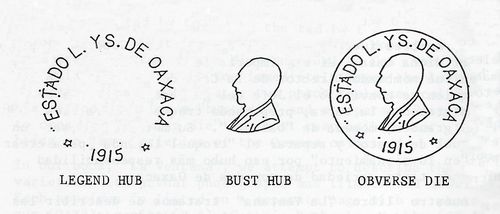
This process was repeatedly used with the ten different bust designs on the various denominations being struck. It is also worth mentioning that the bust hub was never placed in the exact same position on the dies when creating the different dies, therefore some of the busts are frequently offcenter and even slightly slanted. The bust also has the appearance of being small or large depending on the size of the planchet, but the bust is essentially the same size when compared coin to coin.
For example, the bust on 5 centavos will appear large since it takes up a larger portion of the coin surface area compared to a 2 pesos where the bust appears much smaller since there is much more open field surface on the coin. See images below for comparison. On each, the bust size is about the same if not the exact same since most of the bust hubs were reused and often reworked to fit the needs of the specific denomination being struck.

5 Centavos 10 Centavos 20 Centavos 20 Centavos 2 Pesos
22mm 26mm 31mm (large) 28mm (small) 34mm
Example of Bust #6 on five different specimens.
It is also worth mentioning that the mint also made numerous adjustments with the legend which provided even more obverse and reverse varieties. Most of these final changes on the completed die were painstakingly made by hand usually under less-than-ideal conditions. This is evident in the number of re-engraved letters, periods, stars, borders as well as a myriad of die marks and dies scratches than can be seen on the coins. Some dies can also be seen in different states of deterioration, as well as some which have strong die clashes which occurred during the striking process which made for even more interesting varieties on top of an existing variety.
The following is an excerpt from the Tricolor Compendium of Mexican Coinage, Vol. III. It is the single best pictorial reference on the various bust designs of Oaxaca which also includes a reference to the Krause (KM) bust numbers used by the third-party grading agencies for grading and attribution.
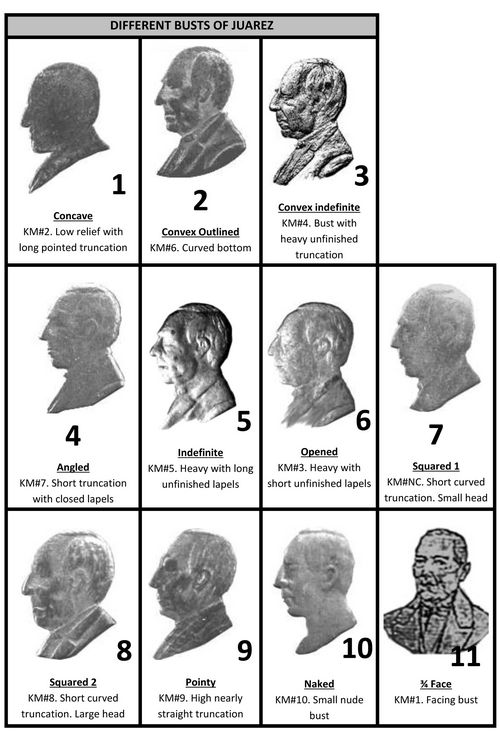
The following is a detailed review of the ten known busts, as well as images of the various denominations which were struck using the specific listed bust variety. AII images are enlarged to a consistent size to show design detail on all denominations, as well as highlight bust positioning.
Juárez Bust #1 - Facing Bust.
The following are images of Bust #1 (KM #1, Amaya #11) which is the only bust with a “facing” design, as opposed to a profile view as evident on all other bust designs. Along with the ¾ facing design, it is also the only variety where the overall bust design is incuse. This bust design was only used on a single 5 centavos variety. It is also one that most collectors will most likely never see in person due to its extreme rarity. It is widely believed this bust design was a pattern that was rejected and abandoned by the mint, most likely due to the complexity of the die.
 |
 |
 |
||
| Krause Bust #1 Amaya Bust #11 (enlarged) |
5 Centavos GB-300 lmage from Guthrie-Bothamley. |
5 Centavos A-OX-19 lmage from Carlos Amaya. |
Juárez Bust #2 - Flat Bust with a Long Pointed Truncation.
The following are images of Bust #2 (KM #2, Amaya #1) which is the only bust with a profile that is fl at or extremely low relief in design. AII other profile bust varieties have more design characteristics than what is seen on Bust #2. This bust also has a concave bottom. It is important to note that this variety comes with several features where parts of the design have sharp or rounded points at the end of the base of the bust. This bust can be seen on four different denominations (1c, 5c, 10c, 20c).
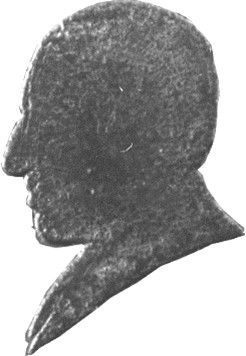 |
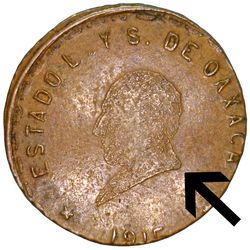 |
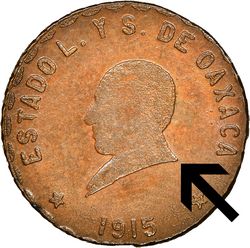 |
||
| Krause Bust #2 Amaya Bust#1 (enlarged) |
1 Centavo LV-5, GB-292, A-OX-3 Rounded right point at the base. |
1 Centavo LV-6, GB-293, A-OX-5 Sharp right point at the base. |
||
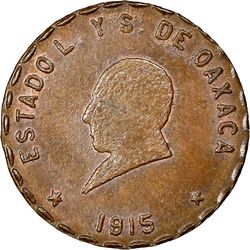 |
 |
 |
||
| 5 Centavos LV-18, GB-UNL, A-OX-25 |
10 Centavos LV-30, GB-318, A-OX-44 |
10 Centavos LV-34, GB-317, A-OX-50 |
Juárez Bust #3 - Short Unfinished Lapels.
The following are images of Bust #3 (KM #3, Amaya #6). This bust is one that is easily confused with other busts of Juárez, especially Bust #4 and Bust #5. Bust #3 is relatively easy to identify if you look at the bottom left of bust where it is easy to see that the lapel detail is short and somewhat incomplete. Essentially, it fades and gives the appearance that it is unfinished, while Bust #4 and Bust #5 show more detail. Note that the date on the gold 5 pesos is located right over the base of the bust. Bust #3 can be seen on eight different denominations (5c, 10c, 20c 50c, $1, $5(Gold), $10(Gold), $20(Gold)).
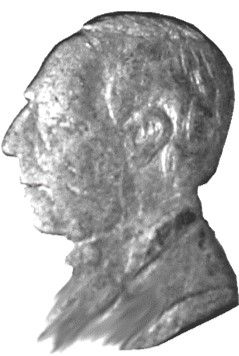 |
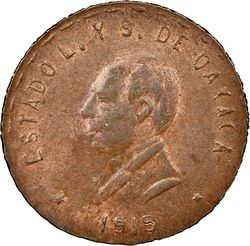 |
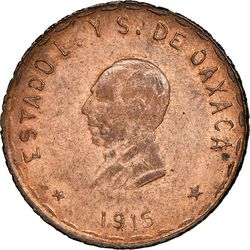 |
||
| Krause Bust #3 Amaya Bust #6 (enlarged) |
5 Centavos LV-26, GB-305, A-OX-39 |
10 Centavos LV-45, GB-311, A-OX-76 |
||
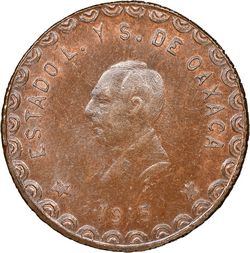 |
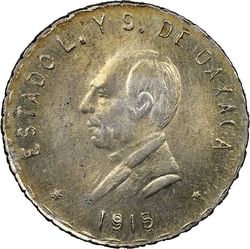 |
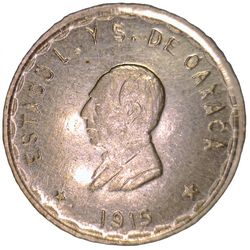 |
||
| 20 Centavos LV-70, GB-333, A-OX-99 |
50 Centavos LV-81, GB-338, A-OX-112 |
1 Peso LV-90, GB-343, A-OX-123 |
||
 |
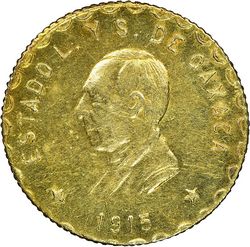 |
 |
||
| 5 Pesos (Gold) LV-123, GB-372, A-OX-170 |
10 Pesos (Gold) LV-125, GB-375, A-OX-173 |
20 Pesos (Gold) LV-126, GB-376, A-OX-174 |
Juárez Bust #4 - Unfinished Truncation.
The following are images of Bust #4 (KM #4, Amaya #3). This bust is one that is easily confused with previously mentioned Bust #3. The Oaxaca Mint appears to have reworked Bust #3 to bring out more details in the lapels on the bottom and top left. It does not fade away quickly like what is seen in Bust #3. The top of the lapel is also slightly more rounded in appearance compared to Bust #3 and Bust #5. This bust can be seen on five different denominations (10c, 20c, $1, $2, $20(Gold)).
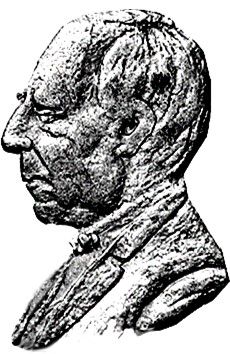 |
 |
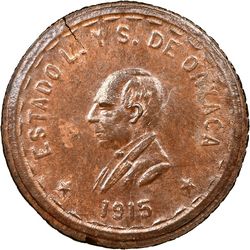 |
||
| Krause Bust #4 Amaya Bust #3 (enlarged) |
10 Centavos LV-52.5, GB-315, A-OX-74 |
20 Centavos LV-68, GB-327, A-OX-97 |
||
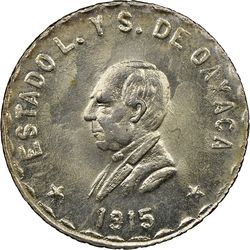 |
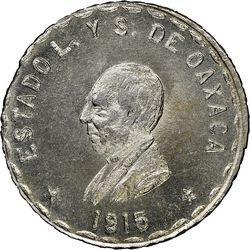 |
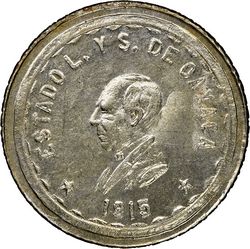 |
||
| 1 Peso LV-93.5, GB-346, A-OX-126 |
1 Peso LV-96, GB-345, A-OX-131 |
2 Pesos LV-113, GB-357, A-OX-153 |
Juárez Bust #5 - Long Unfinished Lapels.
The following are images of Bust #5 (KM #5, Amaya #5). The design has long unfinished lapels and is often confused with previously mentioned Bust #3 and Bust #4. Carlos Amaya describes this bust as “heavy with long unfinished lapels” which shows a left lapel that is a bit longer and better defined than Bust #3 and Bust #4. The top of the lapel is also not as rounded in design as what is seen on Bust #4. Once you better understand the design attributes as well as view the designs side by side, it is much easier to differentiate the three busts in question. This bust can be seen on four different denominations (5c, 50c, $2, $10(Gold)).
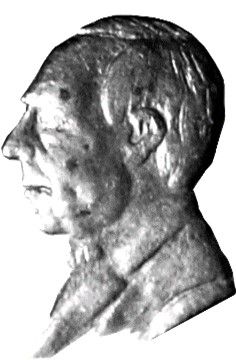 |
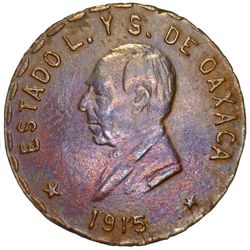 |
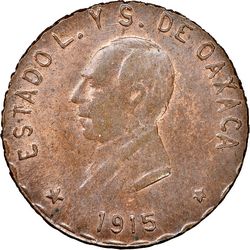 |
||
| Krause Bust #5 Amaya Bust #5 (enlarged) |
5 Centavos LV-23, GB-303, A-OX-34 |
5 Centavos LV-24, GB-UNL, A-OX-36 |
||
 |
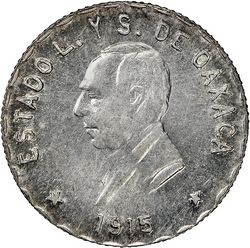 |
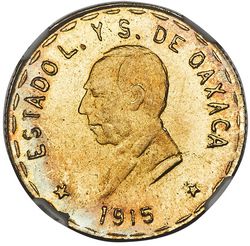 |
||
| 50 Centavos LV-75, GB-UNL, A-OX-108 |
2 Pesos LV-117, GB-352, A-OX-160 |
10 Pesos (Gold) LV-124, GB-374, A-OX-171 |
Juárez Bust #6- Curved Bottom.
The following are images of Bust #6 (KM #6, Amaya #2). This variety is very easy to identify as the bottom portion of the bust is well defined and curved which is quite a stark contrast compared to the bust designs on Bust #3, Bust #4 and Bust #5 which are incomplete and have an inconsistent bust base. This bust was also extremely popular and can be seen on seven different denominations (5c, 10c, 20c, 50c, $1, $2, $5(Silver)).
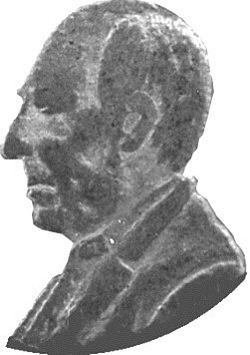 |
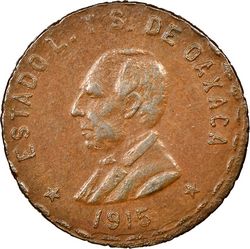 |
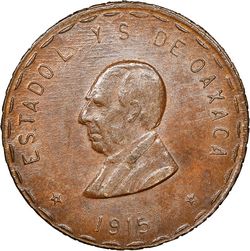 |
||
| Krause Bust #6 Amaya Bust #2 (enlarged) |
5 Centavos LV-20, GB-307, A-OX-27 |
10 Centavos LV-36, GB-UNL, A-OX-53 |
||
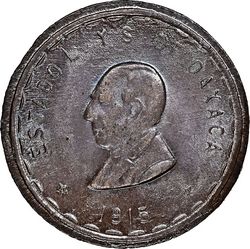 |
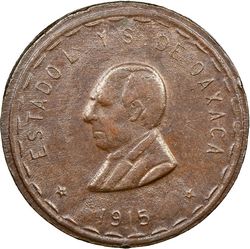 |
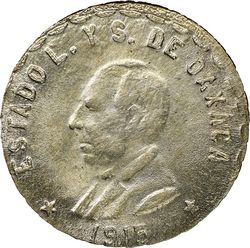 |
||
| 20 Centavos LV-60, GB-328, A-OX-86 |
20 Centavos LV-61, GB-329, A-OX-87 |
50 Centavos LV-77, GB-339, A-OX-106 |
||
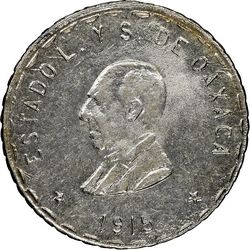 |
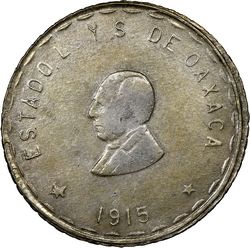 |
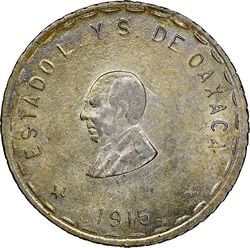 |
||
| 1 Peso LV-86, GB-UNL, A-OX-118 |
2 Pesos LV-108, GB-UNL, A-OX-146 |
2 Pesos LV-109, GB-UNL, A-OX-147 |
Juárez Bust #7 - Closed Lapels with Angled Bottom.
The following are images of Bust #7 (KM #7, Amaya #4). This bust is easily identified since the bottom is well defined and angled and not rounded) like Bust # 6 . Amaya describes this bust as having a “short truncation with closed lapels”. Note that every variety of 3 centavos, except one that has a different bust, has the date located right over the base of the bust, as opposed to an area right below the base of the bust as on the other denominations. Bust #7 is also one of the most popular busts used on the coinage as it can be seen on nine different denominations (3c, 5c, 10c, 20c, 50c, $1, $2, $5(Silver), $20(Gold)).
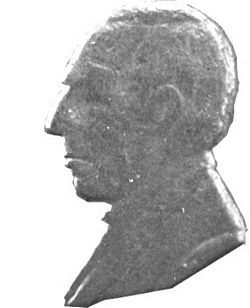 |
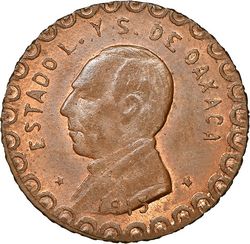 |
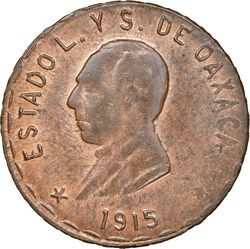 |
||
| Krause Bust #7 Amaya Bust #4 (enlarged) |
3 Centavos LV-13, GB-299, A-OX-17 |
5 Centavos LV-22a, GB-UNL, A-OX-32 |
||
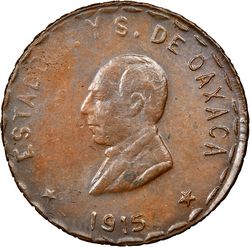 |
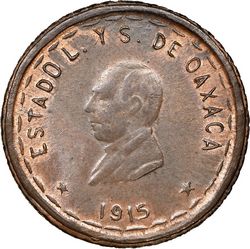 |
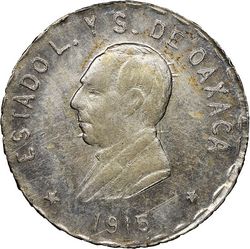 |
||
| 10 Centavos LV-41, GB-UNL, A-OX-62 |
20 Centavos LV-66a, GB-UNL, A-OX-95 |
50 Centavos LV-74, GB-337, A-OX-103 |
||
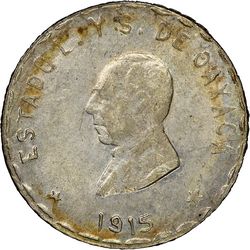 |
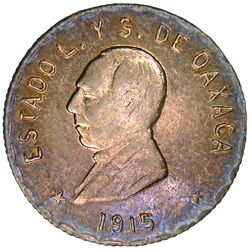 |
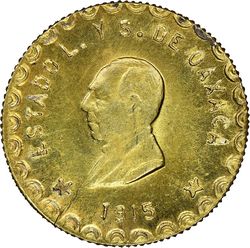 |
||
| 1 Peso LV-88, GB-344, A-OX-121 |
2 Pesos LV-115, GB-351, A-OX-157 |
20 Pesos LV-127, GB-377, A-OX-175 |
Juárez Bust #8 - Short and Curved Truncation.
The following are images of Bust #8 (KM #NC, Amaya #7 small head and KM #8, Amaya #8 large head). Carlos Amaya documents two busts with differing size for this variety. Since they are essentially the same design, I will simply classify them as Bust #8. This bust is easily identified since it has a slightly curved, well-defined truncation. In fact, it is the only bust variety with a short, slightly curved truncation of the lapels. This rarely used bust design is only seen on three denominations (5c, 10c, 50c). Not much is known on the 10c variety (Amaya #7 small head): however it is most likely a pattern.
 |
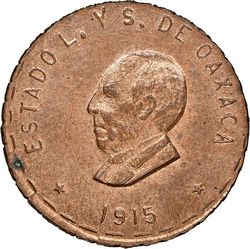 |
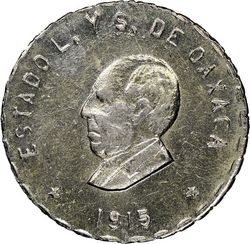 |
||
| Krause Bust #8 Amaya Bust#7 (Squared 1) & Bust #8 (Squared 2) (enlarged) |
5 Centavos LV-27, GB-306, A-OX-40 |
50 Centavos LV-82, GB-340, A-OX-114 |
Juárez Bust #9 - Pointy Straight Truncation.
The following are images of Bust #9 (KM #9, Amaya #9). This design is considered by many to be a rare pattern as it is only seen on the 50 centavos. It is easily identifiable since it has an almost straight base and a short, narrow pointed lapel. The images below are copies of the pictures from Carlos Amaya and Guthrie-Bothamley since higher resolution images were not available.
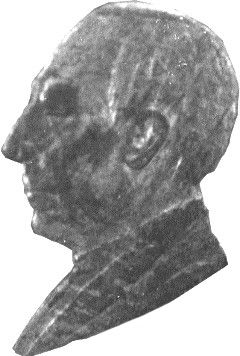 |
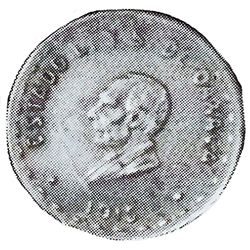 |
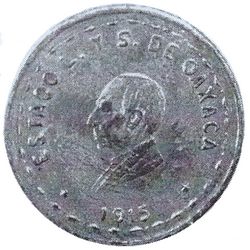 |
||
| Krause Bust #9 Amaya Bust #9 (enlarged) |
50 Centavos LV-71 Image from La Ventana. |
50 Centavos A-OX-101 Image from Carlos Amaya. |
Juárez Bust #10 - Naked Bust.
The following are images of Bust #10 (KM #10, Amaya #10). This design is seen on only two denominations ($2, $60(Gold)). The 2 pesos variety is considered extremely rare and may have been a pattern. Also, it can be seen on what many believe to be the most beautiful issue from Oaxaca which is the 60 pesos struck in gold, silver and copper. Although some believe that the copper strikes are patterns, many others believe that the copper and silver strikes were struck after the revolution using the original dies. For this article, I am not making any assertions regarding the history of those coins but would simply like to focus on the bust design for that particular denomination.
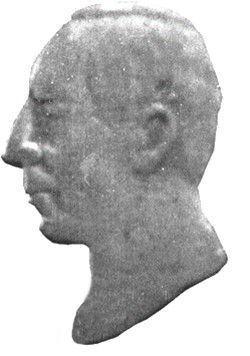 |
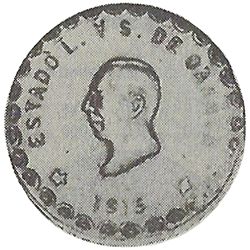 |
 |
||
| Krause Bust #10 Amaya Bust#10 (enlarged) |
2 Pesos A-OX-152 lmage from Carlos Amaya. |
60 Pesos LV-130, GB-379, A-OX-178 lmage from Heritage Auctions. |
The following table is a detailed cross reference between the three major documented sources on the various Oaxaca obverse denominations, busts, and varieties - Guthrie Bothamley (GB), La Ventana (LV) and Carlos Abel Amaya Guerra (A-OX ). Only the varieties which have a bust of Benito Juárez are documented within. I have attempted to document most of the known varieties using these references. However, some were excluded due to space constraints: therefore I strived to only include most of the major known varieties.
| Denomination | Bust | LV | GB | A-OX |
| 1c | 2 | 5 | 292 | 3 |
| 6 | 293 | 5 | ||
| 7 | 294 | |||
| 8 | 295 | 7 | ||
| 3c | 7 | 9 | 296 | 11 |
| 10 | 12 | |||
| 11 | 297 | 13 | ||
| 12 | 298 | 15 | ||
| 13 | 299 | 17 | ||
| 5c | 1 | 15 | 300 | 19 |
| 2 | 16 | 308 | 20 | |
| 17 | 309 | 22 | ||
| 18 | 25 | |||
| 19 | 26 | |||
| 6 | 20 | 307 | 27 | |
| 21 | 28 | |||
| 7 | 22 | 302 | 30 | |
| 22a | 32 | |||
| 5 | 23 | 303 | 34 | |
| 24 | 36 | |||
| 25 | 304 | 37 | ||
| 3 | 26 | 305 | 39 | |
| 8 | 27 | 306 | 40 | |
| 10c | 2 | 28 | 323 | 42 |
| 29 | 43 | |||
| 30 | 318 | 44 | ||
| 31 | 47 | |||
| 32 | 319 | 48 | ||
| 33 | 49 | |||
| 34 | 317 | 50 | ||
| 6 | 35 | 316 | 51 | |
| 52 | ||||
| 36 | 53 | |||
| 37 | 313 | 54 | ||
| 38 | 55 | |||
| 7 | 39 | 59 | ||
| 40 | 60 | |||
| 41 | 62 | |||
| 42 | 61 | |||
| 43 | 310 | 63 | ||
| 43a | 65 | |||
| 64 | ||||
| 44 | 322 | 68 | ||
| 3 | 45 | 311 | 76 | |
| 7 | 46 | 66 | ||
| 47 | 69 | |||
| 70 | ||||
| 48 | 72 | |||
| 6 | 49 | 312 | 56 | |
| 57 | ||||
| 4 | 50 | 314 | 73 | |
| 50a | ||||
| 6 | 51 | 58 | ||
| 4 | 52 | 315 | 74 | |
| 52.5 | ||||
| 53 | 75 | |||
| 7 | 54 | 320 | 77 | |
| 20c | 8 | 78 | ||
| 2 | 55 | 335 | 79 | |
| 6 | 56 | 334 | 80 | |
| 81 | ||||
| 57 | 82 | |||
| 58 | 83 | |||
| 59 | 330 | 84 | ||
| 60 | 328 | 86 | ||
| 61 | 329 | 87 | ||
| 62 | 85 | |||
| 7 | 63 | 325 | 89 | |
| 64 | 90 | |||
| 65 | 91 | |||
| 326 | 92 | |||
| 66 | 324 | 93 | ||
| 66a | 95 | |||
| 4 | 67 | 96 | ||
| 68 | 327 | 97 | ||
| 69 | 331 | 98c | ||
| 6 | 332 | 98b | ||
| 3 | 70 | 333 | 99 | |
| 50c | 9 | 71 | 100 | |
| 72 | 342 | 101 | ||
| 73 | 102 | |||
| 7 | 74 | 337 | 103 | |
| 5 | 75 | 108 | ||
| 6 | 76 | 341 | 107 | |
| 77 | 339 | 106 | ||
| 7 | 78 | 109b | ||
| 5 | 79 | 109 | ||
| 80 | 336 | 110 | ||
| 3 | 81 | 338 | 112 | |
| 8 | 82 | 340 | 114 | |
| 7 | 83 | 341 | 105 | |
| $1 | 6 |
84 | 350 | 116 |
| 85 | 347 | 115 | ||
| 86 | 118 | |||
| 87 | 119 | |||
| 120 | ||||
| 7 | 88 | 344 | 121 | |
| 3 | 89 | 122 | ||
| 90 | 343 | 123 | ||
| 4 | 91 | 125 | ||
| 92 | 124 | |||
| 93 | 346 | 126 | ||
| 93.5 | ||||
| 94 | 349 | 127 | ||
| 95 | 350 | 129 | ||
| 95.5 | 130 | |||
| 96 | 345 | 131 | ||
| 96.5 | ||||
| 132 | ||||
| 97 | 134 | |||
| 98 | 133 | |||
| $2 | 6 | 99 | 135 | |
| 100 | 363 | 136 | ||
| 101 | 138 | |||
| 102 | 366 | 139 | ||
| 103 | 140 | |||
| 104 | 364 | 142 | ||
| 105 | 143 | |||
| 106 | 365 | 144 | ||
| 107 | 367 | 145 | ||
| 107.5 | 145b | |||
| 108 | 146 | |||
| 109 | 147 | |||
| 110 | 361 | 149 | ||
| 111 | 362 | 150 | ||
| 10 | 112 | 360 | 152 | |
| 4 | 113 | 357 | 153 | |
| 114 | 356 | 156 | ||
| 7 | 115 | 351 | 157 | |
| 116 | 353 | 158 | ||
| 354 | 159 | |||
| 5 | 117 | 352 | 160 | |
| 118 | 161 | |||
| $5 (Silver) | 7 | 119 | 163 | |
| 120 | 368 | 165 | ||
| $5 (Copper) | 121 | 371 | 169 | |
| $5 (Silver) | 6 | 122 | 370 | |
| $5 (Gold) | 3 | 123 | 372 | 170 |
| $10 (Gold) | 5 | 124 | 374 | 171 |
| 3 | 125 | 375 | 173 | |
| $20 (Gold) | 3 | 126 | 376 | 174 |
| 7 | 127 | 377 | 175 | |
| 128 | 176 | |||
| 4 | 129 | 378 | 177 | |
| $60 (Gold) | 10 | 130 | 379 | 178 |
| $60 (Copper) | 131 | 381 | 198 | |
| $60 (Silver) | 132 | 380 | 198b |
Summary
This completes my effort to examine and document the ten known bust designs. This has been not only a labor of love for me, but one that I feel is needed for the collector of this series. For years I struggled trying to determine all the different bust types on the various Oaxacan issues. Although most of the information presented was readily available from the previous mentioned publications, many collectors may not own any of the three references which would make collecting the coins in this series difficult. Using these references, positioned me well to consolidate and present the information within this article. It is my sincerest hope that the cross reference chart will be especially helpful when seeking out the varieties to include the appropriate bust on that particular variety. This might also be useful when submitting any Oaxaca revolutionary coinage to the third-party grading companies since they have not been the most accurate with their bust attributions. Even if you do not submit to a third-party grading service, at least you now have the information to help attribute the bust on the coins in your collection which should then help you further identify the particular variety.
Finally, I would like to give appreciation to all my fellow Mexico Revolutionary collectors and dealers who have helped me not only grow my collection over the years, but also provided me with information to help me go forth and conquer the revolutionary coinage world with confidence. I would like to extend a special thanks to Carlos Amaya for allowing me to use the information provided within and for the opportunity to collaborate with him on his Tricolor Compendium set. I would also like to acknowledge Joe Flores and all his contributions with the Oaxaca series and revolutionary coinage in general. Although Joe passed in 2021, I still fondly recall many great conversations with him over the years especially at the annual USMexNA Convention in Scottsdale. He was a true gentleman, and he was always willing to share his knowledge. Lastly, an acknowledgement of Ricardo Medina, Sr. who was the first dealer who encouraged me to expand my horizons by collecting Mexican Revolutionary coinage. Mr. Medina passed away in 2015, but there is not a time I do not think of him when I find a rare or interesting revolutionary coin that I am adding to my collection.
Please send your comments, questions or suggestions regarding this article, to me at
